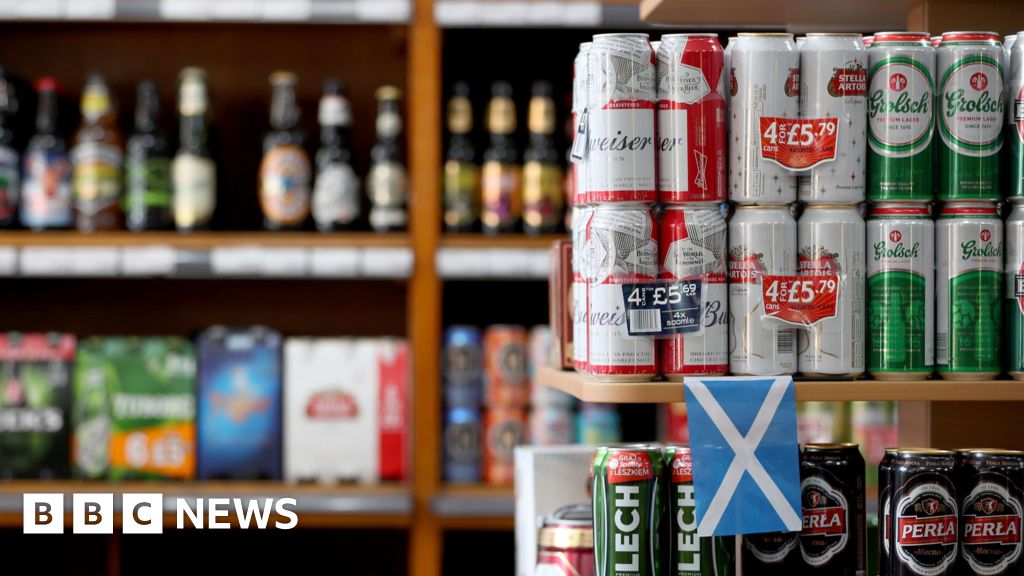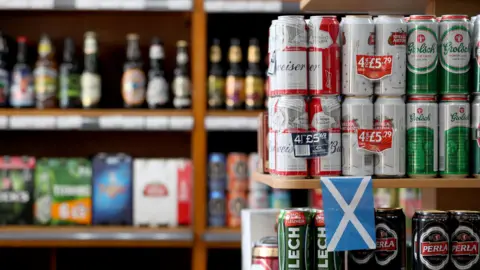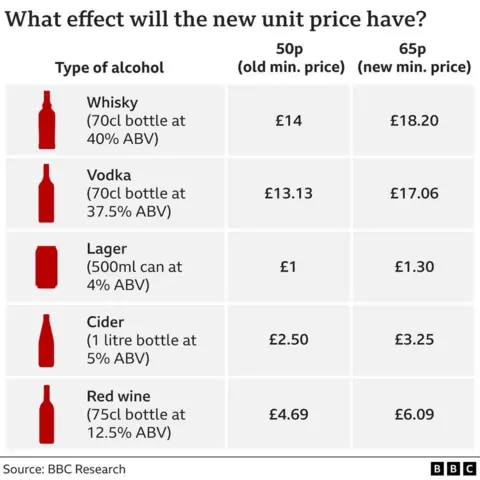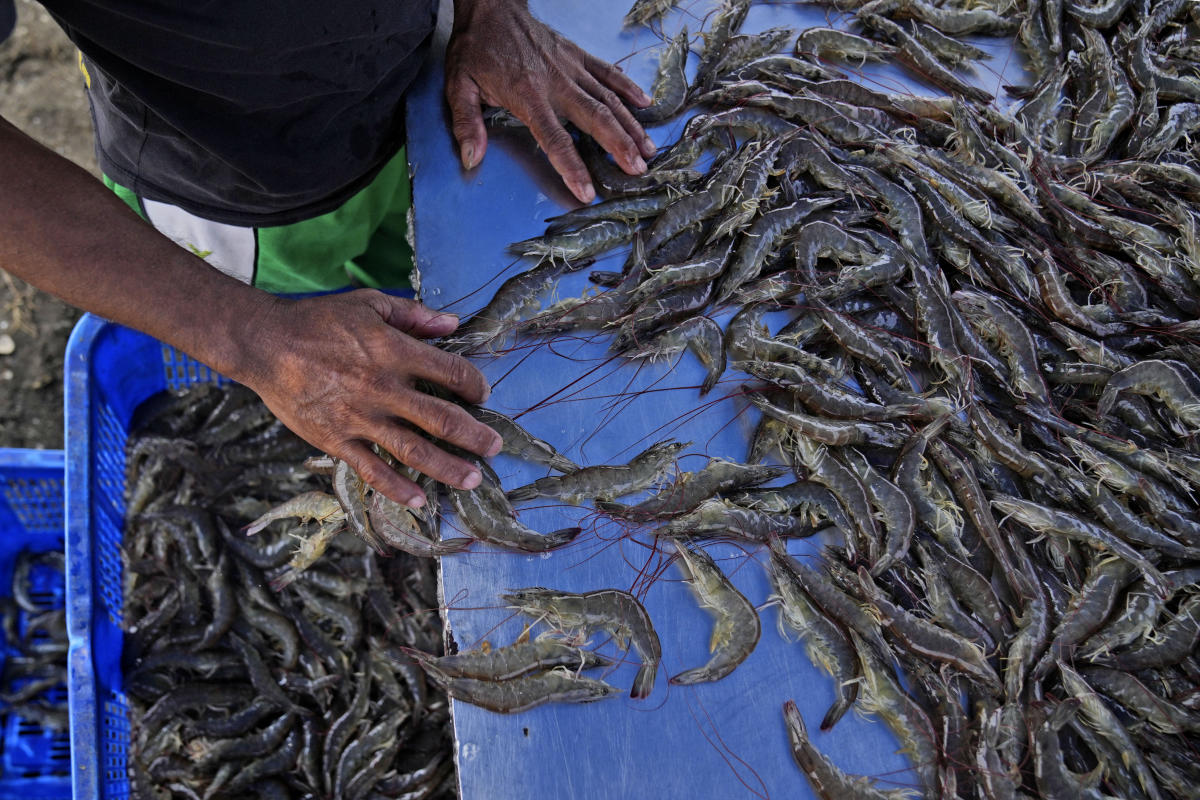BANGKOK (AP) — Indonesian shrimp farmer Yulius Cahyonugroho operated more than two dozen ponds only a few years ago, employing seven people and making more than enough to support his family.
Since then, the 39-year-old says the prices he gets from purchasers have fallen by half and he’s had to scale back to four workers and about one-third the ponds, some months not even breaking even. His wife has had to take a job at a watermelon farm to help support their two children.
“It is more stable than the shrimp farms,” said the farmer from Indonesia’s Central Java province.
As big Western supermarkets make windfall profits, their aggressive pursuit of ever-lower wholesale prices is causing misery for people at the bottom end of the supply chain — people like Cahyonugroho who produce and process the seafood, according to an investigation by an alliance of NGOs focused on three of the world’s largest producers of shrimp provided to The Associated Press ahead of its publication on Monday.
The analysis of the industry in Vietnam, Indonesia and India, which provide about half the shrimp in the world’s top four markets, found a 20%-60% drop in earnings from pre-pandemic levels as producers struggle to meet pricing demands by cutting labor costs.
In many places this has meant unpaid and underpaid work through longer hours, wage insecurity as rates fluctuate, and many workers not even making low minimum wages. The report also found hazardous working conditions, particularly in India and parts of Indonesia, and even child labor in some places in India.
“The supermarket procurement practices changed, and the working conditions were affected — directly and rapidly,” said Katrin Nakamura of Sustainability Incubator, who wrote the regional report and whose Hawaii-based nonprofit led the research on the industry in Vietnam. “Those two things go together because they’re tied together through the pricing.”
Tubagus Haeru Rahayu, the director general of aquaculture for Indonesia’s Maritime Affairs and Fisheries Ministry, said he was surprised by the report’s findings and had already reached out to people in the industry to investigate the price pressures.
“If there is pressure like that, there will definitely be a reaction — not only in Indonesia but in Vietnam and India too,” he told the AP in an interview at his Jakarta office.
Indian and Vietnamese officials refused to comment.
Supermarkets linked to facilities where exploited labor was reported by workers include Target, Walmart and Costco in the United States, Britain’s Sainsbury’s and Tesco, and Aldi and Co-op in Europe.
Switzerland’s Co-op said it had a “zero tolerance” policy for violations of labor law, and that its producers “receive fair and market-driven prices.”
Germany’s Aldi did not specifically address the issue of pricing, but said it uses independent certification schemes to ensure responsibly sourcing for farmed shrimp products, and would continue to monitor the allegations.
“We are committed to fulfilling our responsibility to respect human rights,” Aldi said.
Sainsbury’s referred to a comment from the British Retail Consortium industry group, which said its members were committed to sourcing products at a “fair, sustainable price” and that the welfare of people and communities in supply chains is fundamental to their purchasing practices.
None of the other retailers named in the report responded to multiple requests for comment on the report, titled “Human Rights for Dinner.”
In Vietnam, researchers found that workers who peel, gut and devein shrimp typically work six or seven days a week, often in rooms kept extremely cold to keep the product fresh.
Some 80% of those involved in processing the shrimp are women who rise at 4 a.m. and return home at 6 p.m., with the exception of pregnant women and new mothers who can stop one hour earlier.
“The work day for peelers consists of standing in a refrigerated and disinfected room and working extremely rapidly with a knife while taking care not to make a mistake,” researchers said.
Wages are generally not disclosed ahead of time and are based upon production. Sometimes workers make minimum wage, but frequently they do not.
The Vietnam Association of Seafood Exporters and Producers issued a statement calling the allegations in the report “unfounded, misleading and detrimental to the reputation of Vietnam’s shrimp exports.”
It cited government labor policies in a four-page statement but did not specifically address the findings, and did not respond to queries.
After food supply chain disruptions during the COVID-19 pandemic, the U.S. Federal Trade Commission reported earlier this year that some grocers have used the situation “as an opportunity to further raise prices to increase their profits, which remain elevated today.”
The demands for lower wholesale shrimp prices — combined with rising production costs and an oversupply — means farmers often must sell their products under cost just to keep operations going, the Sustainability Incubator analysis found.
Cahyonugroho said he’s stuck selling his shrimp at the price offered by middlemen who then sell it to factories for processing. He can’t scrape together the startup costs needed to sell directly to factories or markets to earn more.
“The opportunity is there,” he said, “but you need a lot of capital if you want to jump into something like that.”
The middlemen who buy the shrimp obfuscate the true sources of shrimp that appear in Western supermarkets, so many retailers may not be following ethical commitments they’ve made about procuring shrimp.
Only about 2,000 of the 2 million shrimp farms in the major producing countries of India, Indonesia, Vietnam, Ecuador, Thailand and Bangladesh are certified by either the Aquaculture Stewardship Council or the Best Aquaculture Practices ecolabel.
“With the yield from most certified shrimp farms being very small, it is mathematically impossible for certified farms to produce enough shrimp per month to supply all of the supermarkets that boast commitments to purchasing certified shrimp,” the report said.
Ideally, supermarkets should pay higher wholesale prices and ensure that the extra money makes it all the way down the supply chain, Nakamura said.
U.S. policymakers could use antitrust and other laws already in place to establish oversight to ensure fair pricing from Western retailers, rather than adding punishing tariffs on suppliers for labor violations, she said.
Awareness about the trends hurting suppliers is growing.
In July, the European Union adopted a new directive requiring companies to “identify and address adverse human rights and environmental impacts of their actions inside and outside Europe.”
Britain’s Groceries Code Adjudicator office published a “deep dive” into views of suppliers about the conduct of supermarkets, saying they had chosen to conduct “warfare” with suppliers.
Higher wholesale prices don’t have to mean higher prices for consumers, Sustainability Incubator said.
“Prices to farmers would be at least 200% higher than today if the shrimp sold in Global North supermarkets was made at minimum wage rates and in compliance with applicable domestic laws for labor, workplace health, and safety,” the report said. “This would not necessarily mean higher consumer prices, because supermarkets are already profiting at existing consumer prices.”
Researchers from the Corporate Accountability Lab found that Indian shrimp industry workers face “dangerous and abusive conditions” and that highly-salinated water from newly-dug hatcheries and ponds, tainted with chemicals and toxic algae, are contaminating surrounding water and soil.
Unpaid labor prevails, including salaries below minimum wage, unpaid overtime, wage deductions for costs of work and “significant” debt bondage, the report found.
Child labor was also identified, with girls aged 14 and 15 being recruited for peeling work.
In Indonesia, three non-profit research organizations found that shrimp workers’ wages have declined since the pandemic and now average $160 per month, below Indonesia’s minimum wage in most of the biggest shrimp-producing provinces. Shrimp peelers were found to be routinely required to work at least 12 hours per day to meet minimum targets.
Still, given widespread poverty most workers said they’re happy to have their jobs, said lead researcher Kharisma Nugroho of the Migunani Research Institute.
“It’s exploitation of the vulnerability of the workers, because they have a lack of options,” he said.
“They’re paid the minimum wages but they have to work 150% of the normal,” he told the AP. “Can they live? Yes. Can they move? Yes. Do they make a complaint? No. They’re still there.”
The regional report compiled more than 500 interviews conducted in-person with workers in their native languages, in India, Indonesia and Vietnam, supplemented with secondary data and interviews from Thailand, Bangladesh and Ecuador.
After the Indonesia country report was issued recently, government officials asked to meet with the authors, and Nugroho said they showed a “genuine willingness to improve the situation.”
Vietnamese officials have also engaged with Sustainability Incubator to talk about the findings.
Government and industry intervention has already helped in Thailand, which has been criticized after the AP exposed serious labor abuses in the shrimp industry in the past. That, however, has led to higher prices for Thai shrimp, leading some buyers to shift sourcing to India and Ecuador.
Ecuador has an industrial approach to shrimp farming — unlike the smaller, often family-run operations in Southeast Asia — and is now the world’s largest exporter of shrimp. It has the lowest prices, followed by India; China, which wasn’t included in the report; then Vietnam and Indonesia.
But with the demand for lower wholesale prices, while Ecuador’s exports rose 12% in volume in 2023, they fell 5% in value. India’s exports rose 1% but dropped nearly 11% in value.
Meantime, with their relatively higher prices, Vietnam’s exports were down 25% in 2023 in volume Indonesia’s dropped 9.5%.
“Labor exploitation in shrimp aquaculture industries is not company, sector, or country-specific,” the report concluded. “Instead, it is the result of a hidden business model that exploits people for profit.”
___
Associated Press writer Edna Tarigan in Jakarta, Indonesia, contributed to this report.
___
This story was supported by funding from the Walton Family Foundation. The AP is solely responsible for all content.












































































































































You must be logged in to post a comment Login